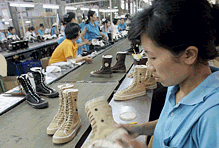
Typical street scene in Santa Ana, El Salvador. (Photo: iStock)
IMF Survey: Joining WTO Will Boost Vietnam's Economy
January 29, 2007
- Cheaper imports should help contain inflation and increase consumer welfare
- Improved access to world export and capital markets should help balance of payments
- Some heavily protected industries and some services will need reforms to stay viable
Vietnam became the 150th member of the World Trade Organization (WTO) on January 11, 2007.

Workers check shoes made for export on factory production line in Hanoi, Vietnam (Hoang Dinh Nam/AFP/Getty Images)
WORLD TRADE ORGANIZATION
Before joining, Vietnam had made great strides toward integration with the global economy. Since 1993, the sum of exports and imports in relation to GDP has more than doubled, and its export market share has more than tripled. With exports becoming a leading engine of growth, GDP growth has averaged more than 7½ percent a year, and poverty has fallen sharply. Given this impressive performance, an obvious question is how the WTO will offer new opportunities and challenges for Vietnam's future.
Improved access
WTO accession will facilitate Vietnam's further global integration. Vietnamese exporters' access to foreign markets should improve as other WTO members are expected to remove remaining quantitative restrictions on imports of Vietnamese textiles and footwear. To be sure, Vietnam will also face greater competition from foreign producers in its domestic market for garments and footwear because its import tariffs and subsidies will be substantially reduced upon accession. However, with improving access to imports of cheaper raw materials and semiprocessed inputs, these sectors are broadly expected to preserve their comparative advantage. The realized benefits for export performance, however, could be tempered by the 12 years it will take Vietnam to gain full "market economy" status.
Import barriers in most other sectors would also decline. As shown in the table, Vietnam has committed to bound tariff rates (or legal ceilings) on most products ranging from zero to 35 percent, although tariffs on cars and motorbikes are to remain somewhat higher, and certain sensitive products (such as eggs, tobacco, sugar, and salt) will be subject to tariff quotas (higher duties for quantities outside the quotas). Reductions in most bound rates—from 17.4 percent on average in 2007 to 13.6 percent by 2019—are to be phased in gradually.
|
| ||||
|
2005 |
WTO initial |
WTO final |
WTO | |
|
Simple average |
18.5 |
17.4 |
13.6 |
up to 12 years |
|
Agricultural products |
29.4 |
27.3 |
21.7 |
up to -5 years |
|
Nonagricultural products |
17.0 |
16.0 |
12.5 |
up to 12 years |
|
Steel |
9.7 |
17.7 |
13.0 |
up to 2 years |
|
Petroleum |
14.6 |
27.2 |
27.1 |
up to 2 years |
|
Manufactures |
||||
|
Textiles and clothing |
36.6 |
13.6 |
13.5 |
upon accession |
|
Footwear |
45.0 |
35.8 |
27.2 |
upon accession |
|
Cars |
63.6 |
84.8 |
58.7 |
up to 12 years |
|
Motorbikes |
100.0 |
100.0 |
74.3 |
up to 12 years |
|
Electronic machinery |
13.3 |
13.9 |
9.5 |
5 years |
|
Minimum tariff |
0 |
0 |
0 |
|
|
Maximum tariff |
150 |
150 |
85 |
|
|
Number of lines |
10,689 |
10,444 |
10,444 |
|
|
Sources: WTO, Vietnamese authorities; and IMF staff calculations. | ||||
Protected industries
But some heavily protected industries, notably auto assembly and motorbike plants, and some services will require significant reforms to remain viable. In particular, fully owned foreign banks will be allowed to compete on an equal footing with domestic banks from April 2007. In this process, there may well be a compression of profit margins and, possibly, some labor shedding in declining industries. The authorities will need to put in place adequate retraining programs and social safety nets to prevent any severe dislocation. Importantly, they will need to accelerate the reform of the state-dominated banking system to enable it to meet the new competitive challenges and improve efficiency in the allocation of capital.
From a broader perspective, WTO accession should have positive long-run effects. Although lower import tariffs can be expected to erode import duty receipts, this should be tempered as the removal of trade barriers spurs import growth. Cheaper imports should also help contain inflation and increase consumer welfare. With access to world export and capital markets improving, the overall balance of payments should remain strong.
Vietnam is also likely to derive important benefits from the other market-friendly reforms it is introducing to meet WTO commitments. Recently adopted laws to unify the regulatory framework for domestic and foreign enterprises and to harmonize rules on trading rights, together with the prospect of accession, have already bolstered the investment climate in Vietnam, and approvals of foreign direct investment reached a record-high $10 billion in 2006. In all, Vietnam seems well placed to capitalize on the opportunities offered by its ongoing international economic integration.


